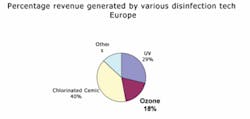European Emerging Trends & Technologies include UV, Ozone
By J Sowmya
Improved techniques of alternative technologies continue to enhance their position against chemical disinfectants such as chlorine and chloramine.
Health risks associated with contaminated water and wastewater and water scarcity issues prevalent in Europe are contributing to growth in disinfection technology use. This market segment includes chlorination and dechlorination equipment, ultraviolet (UV) light, ozone equipment and other technologies such as activated carbon and membranes these technologies may complement.
Disinfection finds use in municipal water and wastewater treatment plants, industries like food and beverages, chemical, petrochemicals, pharmaceuticals and others. The total European disinfection equipment was estimated to be US$485.5 million in the year 2007, with Central and Eastern European markets currently comprising the highest growth segment.
Exciting Trends
Concerns over climate change’s impact on water supplies and scarcity in the region are making water reuse very necessary and promoting growth in the European disinfection market. Water used in industrial processes is treated, disinfected and reused with treatment systems installed within manufacturing units.
Occurrence of serious diseases due to water contamination has made disinfection a necessity. Moreover, EU legislation further boosts this market by pushing demand for new technologies to meet desired standards more effectively.
The market shows a large amount of regional variation with the UK and Ireland generating a major chunk of revenue accounting for about 19.2% in 2007. Chlorination is still the leading treatment method used in water treatment systems while UV and ozonation are expected to continue to increase. Nearly 40% of the revenue to the disinfection market is contributed by the municipal drinking water segment.
Disinfection technologies have found multiple uses in water and wastewater treatment systems across the continent. Ozonation’s include disinfection ofwastewater; colour, odour and taste removal; iron and manganese oxidation; removal of micro pollutants; by-product control, and as a coagulation aid. It also finds extensive use in bottled water disinfection. The technology can be combined with other treatment techniques, such as activated carbon, to remove odour in wastewater treatment systems. Of late, it has seen use with biofilters for higher treatment efficiencies ozone reacts with natural organic matter (NOM) in water and converts it to biodegradable organic matter (BOM), which is removed using biofilters.
UV systems offer an effective, low-cost, environmentally friendly technique and are typically used in municipal water treatment plants to effectively eliminate microbial population. It’s used in combination with RO systems to increase membrane life by destroying biofilms formed on them. UV equipment also finds use in destruction of residual ozone used for disinfection of tanks, pipelines, etc., as well as residual chlorine and chloramines used in chemical treatment of water. Domestic UV treatment units also are gaining wider popularity as they help purify and remove color and odour from water.
Fast Growing Technologies
It’s further anticipated that UV and ozonation markets are likely to experience the fastest growth over the long term in the disinfection market. This is because conventional chemical treatment methods, though effective, have the disadvantage of generating harmful side effects disinfection by-products (DBPs) due to sometimes high levels of residual chlorine in municipal drinking water. Chlorination as a treatment method can be used in the paper and pulp industry but isn’t always a desirable method for other industrial process water treatment. Such disadvantages are limited for UV and ozonation and hence both are gaining popularity. Moreover increasing public awareness regarding water disinfection has led to increased use of domestic/household water treatment equipment to solve associated colour, odour and taste problems as well as potential health issues. Changing consumer lifestyles and increasing purchasing power also contributes to growth of this segment in the European disinfection market.
Of these two technologies, the UV treatment equipment market is expected to grow more than the ozonation market due to lower equipment prices. The UV treatment market is estimated to be around US$149.2 million in 2007. German, British, Irish and Italian markets contribute 53% of the total UV equipment market. The ozonation treatment market was estimated to be US$90 million in 2007, and is particularly strong in France and the UK.
Technology Developments
Innovations are taking place in the UV treatment systems sector to improve performance efficiencies. Computational fluid dynamics modeling is the latest technique employed to create optimized UV systems to be available in the European markets in the next few years. The advantage of using these optimized reactors is to enhance UV dose delivery and reduce energy costs. More advanced energy sources are being researched namely Light Emitting Diodes (LEDs) and microwaves. Their use will increase lamp life and energy output.
Conclusion
These technological improvements will increase disinfection efficiency, lifetime of the UV system and reduce energy costs. It’s foreseen due to these advantages that UV systems will have an edge over ozonation equipment in the market over the next few years. Chlorination will remain strong, but growth opportunities are limited by enhanced disinfection of these and other emerging technologies.
Author’s Note:
J Sowmya is a research analyst with the Environment Group of Frost & Sullivan in the global growth consulting and market research firm’s London office. Contact: +44 (0) 20 7730 3438 or www.environmental.frost.com

